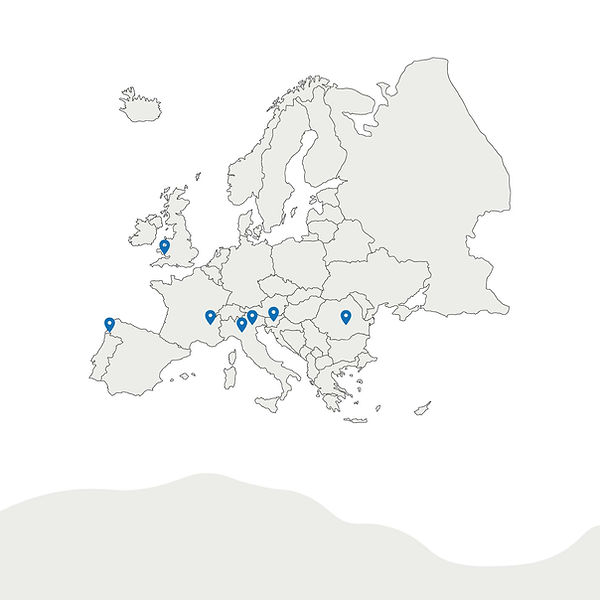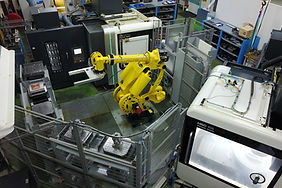SME-Driven Experiments
A SME-driven experiment is the demonstration of the development and implementation of an AI-based solution in a real industrial environment. It is driven by the collaboration among a technical provider who collects the needs and develops the AI solution and an industrial company who explains the current AS-IS scenario and demonstrates the feasibility of the adoption of the solution. The beneficial impact of the use of AI will be evaluated through the monitoring of specific Key Performance Indicators (KPIs).
Each experiment is carried out in two iterations, the second iteration being either an incremental development of the first one or a different case.

Experiments
Real time monitoring for control and detection of production – Lombardy (IT)


The use case focuses on the application of monitoring technologies for process self-adaptivity to a sheet metal pressing line as any variation in processes’ parameters could lead to non-conformity of the final product. The plant consists of five presses in series that have the task of gradually deforming the sheet metal by applying a predefined load. The line is currently equipped with a control software that allows the setting of process parameters while monitoring is limited to specific technical parameters. The integration of the line control software with edge technologies will allow the data to be accessed and processed, enabling the quantitative characterization of the line’s operating conditions, the assessment of process quality and the determination of any deviations in an objective manner. Moreover, through edge computing technologies, it is possible to apply AI methodologies to operating data to carry out knowledge extraction, allowing to pass from quantitative data to structured information.
AI for agility in mould making - Auvergne Rhone Alpes (FR)


The Experiment aims to demonstrate the impact of Artificial Intelligence on the shopfloor regarding productivity and agility by predicting and organized manufacturing sequences.
In a first iteration we start with an audit with support from Polymeris partners. This leads to split the experiment in two parts, the method side (manufacturing sequences prediction) and the planning side (advice planning change). On the planning side the expert guides us towards an existing tool call Speed Ordo. On the method side, we used image recognition to extract information from the 3D file in order to link them to the tasks needed to manufacture a steel part. The planning side works well and suits to our aims, meanwhile the method side doesn’t work, image recognition isn’t precise enough and doesn’t differentiate between the mold elements.
The second iteration starts with the conclusion that image recognition alone is not sufficient, so we introduced more information, such as colors on the different faces of the mold elements that are used to define the functionalities of the faces (It is today used to create the manufacturing sequences) or the name of the elements that allow to group them by family (simple, but very important characteristic to work step by step). The results are much better, and even if we are still far from the “free” introduction in the organization, we see good results on specific families, it is promising!
During the two experiments, a particular attention has been applied on our employees by introducing sensibilization and training activities.
Next, we will continue to work on the data family by family in order to validate more families and finalize the integration of the tool.
AI at the Edge for Zero Defect Food Industry and Sustainability Gain – Galicia (ES)


The Spanish SME leading this pilot is Quescrem, a cream cheese manufacturing company in the dairy industry that has always been heavily committed to innovation, by creating high-quality products for the food industry and the professional cooking and bakery, as well as for consumers. Within this context, this SME-driven experiment focuses on the application of AI and Edge technologies to improve the quality of Quescrem’s end product and to reduce waste, in order to improve sustainability. The idea is to use sensorized process data (temperatures, pressures, nutritional characteristics of the ingredients, etc.) stored in Quescrem’s systems, as well as real-time data streams collected from its production lines, in order to prescribe the optimal parameters that ensure the provision of a high-quality output (e.g. homogeneized cream cheese texture) and improve efficiency as well. To this end, Gradiant is supporting Quescrem in the development of this pilot taking on the role of technology provider for the experiment, being a Spanish ICT technology center with more than fifteen years of experience in the fields of connectivity, intelligence and security. Gradiant is developing real-time analysis of Quescrem's manufacturing process data through AI algorithms at edge level, which will enable the discovery of complex patterns and the provision of accurate predictions and prescriptions that support decision making.
AI-based autonomous machine for safer faster agriculture – Trentino (IT)


Aim of the experiment is to create an autonomous agricultural machine to make human work more secure. There are in fact some situations where the agricultural land is very steep, and the rows of trees are very narrow. In these conditions the manoeuvre of the machine might be dangerous for the driver and, on some occasions, even fatal. The objective is to create a prototype of a semi autonomous agricultural machine that is able to follow the path between the treelines. To enable this function will be used a pool of sensors robust to the weather condition and the environment, able to recognize road trees, obstacles and measure distances. The hardware will be selected in order to process images and, through AI, evaluate movements depending on the objects around. The system will interface with the existing driving equipment and interact with the machine control unit.
Intelligent Contextualised Visual System for error reduction – Wales (UK)


The experiment will integrate different production systems (inc. Industreweb™, PLCs and other control devices), embedded technologies (AI, CPS, IoT) and human operator knowledge, into a single unified digital visualisation platform. Using the AI REDGIO 5.0 architecture, all relevant systems being developed will be connected to create added value within the production process, enabling a variety of outcomes, including the access to specialised knowledge in the production system and to production data for process improvement and efficiency, and the transfer of human-to-machine and machine-to-human knowledge.
Quality Assurance of clothing production - (RO)

.jpg)
The use-case consists in testing the product defect detection system prototype integrating AI-at-the-edge technology developed during the project. System installation with local network connectivity will be set up on the QA production zone of KAF to capture product images with low occlusion and good, consistent lighting. Several relevant types/styles of clothing products will be used for the experiment. Images are captured with the edge device, annotated in real-time by the operator, and subsequently used to train a neural network to recognize various defect types. Furthermore, the possibility of triggering an automated model building workflow to include a sequence of steps including data augmentation, model training, and postprocessing will be evaluated.
Continuous monitoring of moulding machines using AI at the edge (SI)


This experiment is led by the Slovenian company Polycom, which is primarly oriented towards injection moulding of demanding technical products for the automotive industry, compression technology, electrotechnology and electronics. To maximize the availability of their production machines and hence production quality and efficiency, the process operations need to be continuously supervised. The addressed scenario consist of the data infrastructure, edge device and algorithms that were developed to estimate the condition of the moulding process and to detect process deviations. Firstly, a data infrastructure was established to collect process data. Further, the developed algorithms were implemented to detect changes in nominal distribution patterns of the crucial process parameters and to faster suggest the type of the upcoming fault. The obtained new insight is provided to operators to better control the process and plan maintenance activities.













.png)






